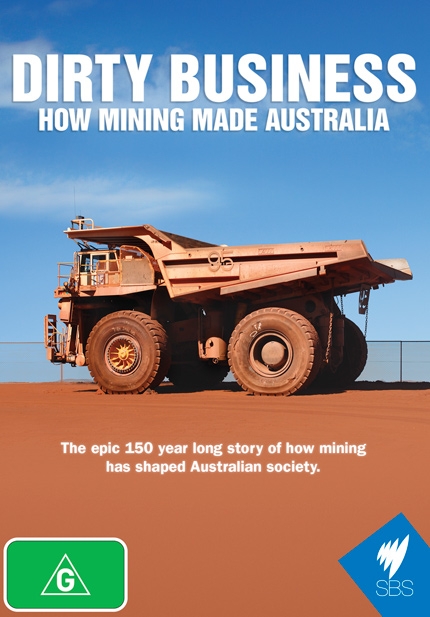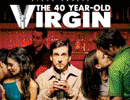Dirty Business: How Mining Made Australia (2012) |
|
Dirty Business: How Mining Made Australia (2012) |
|


|
| BUY IT |
| General | Extras | ||
| Category | Documentary |
Featurette-Making Of-The making of Dirty Business (9:28) Interviews-Cast-Interview with Professor Andrew Reeves (2:16) Interviews-Cast-Interview with Sir Arvi Parbo (4:28) Interviews-Cast-Interview with Bruce Harvey (5:38) Interviews-Cast-Interview with George Megalogenis (2:38) Interviews-Cast-Interview with Jacqui Katona (4:43) Interviews-Cast-Interview with Justin O'Brien (10:17) Interviews-Cast-Interview with Professor Marcia Langton (4:44) Interviews-Cast-Interview with Robert Macklin (4:32) Interviews-Cast-Interview with Trevor Sykes (4:36) |
|
| Rating |

|
||
| Year Of Production | 2012 | ||
| Running Time | 168:45 (Case: 156) | ||
| RSDL / Flipper | Dual Layered | Cast & Crew | |
| Start Up | Menu | ||
| Region Coding | 4 | Directed By | Jacob Hickey |
|
Studio
Distributor |
 Madman Entertainment |
Starring | Colin Friels |
| Case | Amaray-Transparent | ||
| RPI | $29.95 | Music |
Dale Cornelius Mark Ingram |
| Video | Audio | ||
| Pan & Scan/Full Frame | Unknown | English Dolby Digital 2.0 (224Kb/s) | |
| Widescreen Aspect Ratio | 1.78:1 | ||
| 16x9 Enhancement |
 |
||
| Video Format | 576i (PAL) | ||
| Original Aspect Ratio | 1.78:1 | Miscellaneous | |
| Jacket Pictures | No | ||
| Subtitles | English | Smoking | No |
| Annoying Product Placement | No | ||
| Action In or After Credits | No | ||
Dirty Business: How Mining Made Australia is a three-part series documentary on the history and current impact of Mining on Australian society. It aired on the SBS channel in January, 2013. It aims to present a fuller account of the role that Mining Companies and Governments have played in conflicts and disputes from the time that mining started to change Australia, when gold was discovered in New South Wales and Victoria in the 1850s. The series has been split into three main themes: Money, Power and Land. Series Producer and Director, Jacob Hickey aimed to make this documentary series in chronological order, yet changed his mind when he saw these three main themes as the source of modern and historical conflicts in relation to mining in Australia.
The general synopsis, from the producers, is that Dirty Business: How Mining Made Australia is a saga of heroes and villains, greed and glory, power and politics, death and destruction, boom and bust.
In 150 years nothing has influenced Government, the economy, and the lives of the majority of Australians like mining. From the gold rush to the boom, it has turned the wheels of the Australian economy. It has generated trillions of dollars, provided employment across generations and enabled the nation to dodge the worst impacts of depression and global financial crises. In the midst of continued global economic uncertainty, mining giants are making billions, but mining in Australia is much more influential than even the mind-numbing figures suggest.
Mining affects us all, it is as influential as it is risky. The ultimate high wire act, it teeters between unimaginable riches and catastrophic collapse. Mining is what makes us rich even as it threatens to destroy the dream it has built. This series reveals how this knife -edge drama has played out repeatedly through Australia’s history. Dirty Business: How Mining Made Australia does this in three themed episodes covering Money, Power and Land.
This documentary reveals how mining initially made the distant British colony rich, and how the struggle for who gets to share in the wealth has raged across a century and half ever since. The promise of wealth beyond belief brought a tsunami of humanity to these shores. It built the first multi-ethnic Australia and the cities in which we live. But the fear that the sudden mineral booms would turn to dust just as suddenly, stalked colonial Australia and drove fierce competition which pitted miner against government, miner against miner, and race against race. (Episode One - MONEY)
Mining has always been about politics. Today we think the relationship between business and Government is fractious, drama filled and utterly critical to the nation. In fact it has always been this way.
From Eureka in the 1850s to Federation in 1901, mining built the nation and formed the foundation of the nation’s modern democracy. Yet as mining developed Australia so Australia’s miners, often with the Government’s blessing, became more and more powerful. Australian mining become a global, internationally owned, , all-powerful, unelected industry that wields enormous power and influence. A business that Australia’s Prime Ministers from Billy Hughes to Julia Gillard ignore at their peril. (Episode Two - POWER)
For one hundred and fifty years, mining and European penetration of the vast continent have gone hand in hand - one only possible because of the other. On one level it is a romantic tale of frontier discovery, of world beating technological achievement and people’s great pioneering spirit.
On another level it is very different and chilling, it's the story of how mining has been central to the dispossession of aboriginal peoples; their cultures and the destruction of their land. In the modern era, mining has been central to the politics of land rights especially in the north and centre of the continent , and some indigenous leaders are now saying that in those regions, ironically, it represents the best hope for future aboriginal self-determination and economic independence. (Episode Three - LAND)
From the fate of the First Australians, and the land itself, to politics and society, this series tells the story of how deeply mining has shaped the face of the nation. It will continue to do so, because our fate is so intimately entwined with the precious treasure trove contained in the ancient rocks of this ancient continent.
This is a superbly-made documentary, from the use of aerial long-distance shots, to 3D camera mapping, sound effects, set production and interviews with respected Australian mining identities, journalists and academics. This series is vital if you want to enhance your understanding of the history of Australia as a nation.
As this is a documentary, there is extensive use of 3D camera mapping (i.e. transforming 2D images into 3D), archived footage, aerial pick-up shots of mines and scenes with interviewees, so don't expect the video transfer to be on par with a Hollywood-produced film!
The aspect ratio is 1:78:1, 16x9 enhanced for widescreen televisions. This series was made for television viewing.
The clarity of the image varies as archived film and photography is used extensively. Other scenes are sharp, including the aerial footage of mines and scenes with interviewees, shot on a set made to look like a mine!
The colour scheme can be described as bright and vivid for modern scenes, and dull and lifeless for historical scenes. I believe a fair-bit of creative decision-making went into the shooting of this documentary to support the themes that are presented, hence these variations!
Due to archived footage being used, there is film grain and low level noise evident in the transfer. The average bitrate of the three episodes is 4.70 m/b per sec, which is a little low for DVD. Do remember, that this was made for television viewing, and there is almost 4 hours of episodes and extras on the DVD included here.
Subtitles are available in English for the hard of hearing for the three main episodes of the documentary, but not the extras. They are in yellow.
| Sharpness | |
| Shadow Detail | |
| Colour | |
| Grain/Pixelization | |
| Film-To-Video Artefacts | |
| Film Artefacts | |
| Overall |
The audio soundtrack is well-done, even if it is a basic one, with violins, guitars and ambient sound effects supporting the main themes.
The main audio track is a Dolby Digital 2.0 track encoded at 224 kbps.
The dialogue, mainly narrated by Colin Friels (I bet you won't recognise him - his voice has been pitch-altered slightly lower to sound more authoritative, in my opinion) is clear.
The soundtrack has been put together by Mark Ingram, with Dale Cornelius providing original musical themes. In my opinion, it has been put together vey well!
As this a stereo soundtrack, made for television, Surround Channel Usage is limited and there are no subwoofer effects utilised.
| Dialogue | |
| Audio Sync | |
| Clicks/Pops/Dropouts | |
| Surround Channel Use | |
| Subwoofer | |
| Overall |
NOTE: To view non-R4 releases, your equipment needs to be multi-zone compatible and usually also NTSC compatible.
The Region 4 version of Dirty Business: How Mining Made Australia is the only version currently available.
If you think you know the history of Australia, after watching this documentary you'll realise that you don't, especially if you are relying on what you learnt in school! Facts such as Gina Rinehart's net worth of $AU22 billion (It is revealed as $AU29 billion in the documentary - that figure has been revised by BRW recently) started from a royalty agreement with no sunset clause with Rio Tinto, former US President Herbert Hoover's influence upon the WA mining industry when he worked there in the late 19th century, the construction of the Goldfields Water Supply Scheme 530 km pipeline in 1903 brought water from Perth to Kalgoorlie, and has contributed greatly to economic growth in Australia since and Sir John Forrest's (the first Premier of Western Australia) use of universal suffrage in the 1890s, by allowing women the right to vote to further his political ambitions, are all examples of important facts that are presented in this documentary. Do yourself a favour and catch a viewing of this excellent documentary on Australian Mining, you'll be glad you did!
| Video | |
| Audio | |
| Extras | |
| Plot | |
| Overall |
| Review Equipment | |
| DVD | Sony BDP-S550 (Firmware updated Version 020), using HDMI output |
| Display | Samsung LA46A650 46 Inch LCD TV Series 6 FullHD 1080P 100Hz. Calibrated with THX Optimizer. This display device is 16x9 capable. |
| Audio Decoder | Sony STR-K1000P. Calibrated with THX Optimizer. |
| Amplification | Sony HTDDW1000 |
| Speakers | Sony 6.2 Surround (Left, Front, Right, Surround Left, Surround Back, Surround Right, 2 subwoofers) |